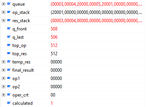NightOWL
Newbie level 3
Hello, I have to project a specialized calculator on a Basys3 board using VHDL. The calculator should be able to group numbers using brackets, perform additions and substractions, AND and OR operations. For example, an expression could be: 4 + 5 AND 6 +(7 OR 1) - (4 AND 10)
The input numbers are 4 bit numbers (in my code I used 5 bit numbers, the most significant bit being the sign bit) and the output can be max. 16 bits long (i used 17 bits in my code, the most significant being the sign bit).
I wrote the code for the ALU (the adder/substractor, AND/OR) and I managed to make the calculator work for 2 numbers as inputs(using 2 in ports). This is the "main" code for the calculator, that i have written:
However, the calculator should work for N numbers as inputs (using only one in port) and I don't know how to do it. I thought about memorising the whole expression(operartors and operands) in a FIFO or LIFO memory (but I'm not sure if that could work) and then making the calculations but I don't know how to calculate everything in the correct order given by the priorities and where(and how) to memorise the temporary results.
I thought that maybe you could give me some ideas, I'm new to VHDL, I'm a student and I have just started learning it and I got stuck at this part in the project.
Thanks!
The input numbers are 4 bit numbers (in my code I used 5 bit numbers, the most significant bit being the sign bit) and the output can be max. 16 bits long (i used 17 bits in my code, the most significant being the sign bit).
I wrote the code for the ALU (the adder/substractor, AND/OR) and I managed to make the calculator work for 2 numbers as inputs(using 2 in ports). This is the "main" code for the calculator, that i have written:
Code:
library IEEE;
use ieee.STD_LOGIC_1164.all;
use ieee.STD_LOGIC_UNSIGNED.all;
entity calculator is
port(X: in STD_LOGIC_VECTOR(4 downto 0); -- X(4) sign
Y: in STD_LOGIC_VECTOR(4 downto 0);
OPERATIE: in STD_LOGIC_VECTOR(4 downto 0);
CLK, CLR: in STD_LOGIC;
a_to_g: out STD_LOGIC_VECTOR(6 downto 0);
an: out STD_LOGIC_VECTOR(3 downto 0);
negativ: out std_logic);
end calculator;
architecture calculator of calculator is
component ALU is
port(A,B: in STD_LOGIC_VECTOR(16 downto 0);
COMANDA: in STD_LOGIC_VECTOR(4 downto 0);
RESULT: out STD_LOGIC_VECTOR(16 downto 0));
end component;
component BCD_7seg is
port(X: in STD_LOGIC_VECTOR(15 downto 0);
CLK, CLR: in STD_LOGIC;
a_to_g: out STD_LOGIC_VECTOR(6 downto 0);
an: out STD_LOGIC_VECTOR(3 downto 0));
end component;
signal OPERAND_1: STD_LOGIC_VECTOR(16 downto 0) := (others => '0');
signal OPERAND_2: STD_LOGIC_VECTOR(16 downto 0) := (others => '0');
signal TEMP_RESULT: STD_LOGIC_VECTOR(16 downto 0) := (others => '0');
begin
operand_1(3 downto 0) <= x(3 downto 0);
operand_1(16) <= x(4);
operand_2(3 downto 0) <= y(3 downto 0);
operand_2(16) <= y(4);
calculate: ALU port map(operand_1, operand_2, operatie, temp_result);
afis: BCD_7seg port map(temp_result(15 downto 0), clk, clr, a_to_g, an);
negativ <= temp_result(16);
end calculator;However, the calculator should work for N numbers as inputs (using only one in port) and I don't know how to do it. I thought about memorising the whole expression(operartors and operands) in a FIFO or LIFO memory (but I'm not sure if that could work) and then making the calculations but I don't know how to calculate everything in the correct order given by the priorities and where(and how) to memorise the temporary results.
I thought that maybe you could give me some ideas, I'm new to VHDL, I'm a student and I have just started learning it and I got stuck at this part in the project.
Thanks!
